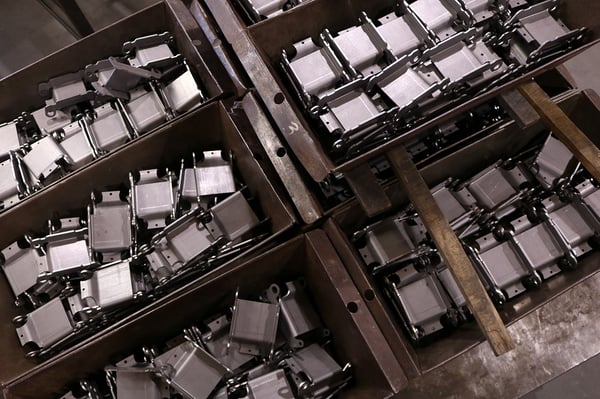 So your next design – be it a dishwasher, smoker, tanning bed, refrigerator, or another piece of equipment – needs the support and reliability of heavy duty industrial hinges. You’re working on your hinge design calculations and material specs, and things are getting complicated.
So your next design – be it a dishwasher, smoker, tanning bed, refrigerator, or another piece of equipment – needs the support and reliability of heavy duty industrial hinges. You’re working on your hinge design calculations and material specs, and things are getting complicated.
How you follow – or don’t follow – the hinge design guidelines below can make or break your product’s quality and safety. Use this checklist to ensure you’ve considered every possibility before sending your stuff to the assembly line.
9 Guidelines Involved in Designing Heavy Duty Industrial Hinges
Mechanical hinge design includes at least nine crucial considerations:
- What’s the hinge’s useful life?
- How much should the hinges cost?
- What are your material requirements?
- Will the equipment be located in a challenging environment?
- How much load will the hinge bear?
- What are the safety requirements?
- What kind of movement should the attached door or cover make?
- How much space within the equipment do you have to work with?
- How important is appearance?
Resource: Want to design your own counterbalance hinge? Click below to learn how:
1. Life Cycle
The durability you expect from your hinge is critical to your bottom line and may affect the usability of the entire product years from now.
Many hinge manufacturers can design to a specific desired life cycle. Opening a refrigerator five times a day, seven days a week, will likely not require the same design as a cryogenic freezer that a customer wants to last for 100,000 cycles.
The life cycle expectancy calculation largely depends on how often you expect the hinge to be activated. Use this as a rule of thumb:
- High-frequency traffic: Doors, covers, and lids with more than 25 uses per day, weighing up to 200 lbs. and/or sustaining a lot of slamming
- Low-frequency traffic: Lids, covers, and doors with 10 or fewer uses a day and weighing up to 1,000 lbs.
Your desired product lifetime may affect material choice, too. If you only want a 10,000-cycle life, you can stick to low-price steel alloys.
If you plan to rely on your manufacturer for reliability testing, communicate the number of hinges you’d like to see successfully tested.
2. Target Price
The customer supplies the target price and the desired life cycle, and it’s up to the hinge manufacturer to match that as closely as possible.
Finding the right compromise between price and performance might mean substituting materials and other design elements, but that shouldn’t always mean a reduction in quality. For example, bronze bushings are good in high heat, but so are other, less expensive solutions made from heat-resistant plastic.
3. Material Requirements
Understanding your price point, durability needs, and end-use environment will help you choose the best materials. Other factors may include desired appearance (i.e., shiny stainless steel vs. drab carbon steel), UV resistance needs, and weight.
For example, you might look at plastics for noise and vibration reduction.
Additionally, you can use powder-coated steel for added protection in challenging environments. Inside a counterbalanced hinge used around food, you can adopt a “food-approved lubricant” to eliminate potentially harmful contamination.
4. Location
Like real estate, hinge design is about location, location, location. Where your equipment will end up affects its design:
- Wet and corrosive environments require materials like stainless steel that can withstand those challenges.
- High-heat applications like grills and French door ovens automatically rule out gas springs and require special materials like chrome silicon in your mechanical springs.
- A hinge in a commercial application may suffer extra wear and tear if it’s in a public space, so you’ll need more durable materials.
5. Load Bearing Capabilities
Motion control requires counterbalancing. Counterbalancing requires finding the center of gravity and other complex calculations. You can find the center of gravity yourself or rely on a hinge supplier with an experienced engineering team instead.
The best hinge manufacturers can help you achieve a certain “feel” to the lid or cover. For example, with the proper calculations, you can make a 75-lb. smoker lid feel like 5 lbs. to the person lifting it.
In your calculations, include the maximum weight of any decorative panels or handles you’ll attach to the door or cover.
6. Safety
Depending on the hinge’s application, you might have regulations to meet. For example, NSF International ensures buyers that the product meets public health protection standards. You may also have to consider other regulations, including those governing electrical components in appliances.
If you’ve had any past problems with liability due to a slamming lid or failed gas cylinder, talk to your hinge maker about your new or revised design. The more your manufacturer knows about what went wrong, the more it can help guide you to a safer, more reliable solution.
7. Motion
For heavy lids, covers, and doors, motion control features can add:
- Convenience
- Safety
- Value & a luxurious feel
The possibilities of motion control for a cover or lid may be greater than you realize:
- Counterbalanced
- Soft-open
- Soft-close
- Detent
- Lock in place
Your motion control needs may also affect the layout and size of your hinges.
8. Available Space
How much room you have for hinges inside the equipment determines the hinge size.
Make sure your design plans consider hinge size, especially if you want it hidden inside the product. A smaller hinge might help you hide the hinge but may limit its load-carrying capacity.
Lastly, don’t forget about DFM (design for manufacturability) and installation. Your design may not come off the production line at all if it can’t be manufactured successfully. And if installation is a pain because you didn’t account for space concerns, you’ve worked yourself into a corner.
9. Aesthetics
It’s only worth investing in certain materials or design choices if the product’s end use calls for a pleasing aesthetic.
Will the hinge be used in an application where looks matter? If so, a hidden hinge might be the best solution. Alternatively, you can opt for visible hinges that match the location’s color scheme to help it blend in.
If you’re unsure whether to sink money into a good-looking hinge design, consider whether it will matter to the end customer.
Communication is the key to Designing Great Heavy Duty Industrial Hinges
The best way to get what you want from a heavy duty industrial hinge is to communicate with your manufacturer. While you may only have a passing knowledge of motion control design, the manufacturer probably has decades of experience with it.
The more information you provide up-front – and the more questions your manufacturer asks in return – the better. Teamwork is the most important element in good contract manufacturing.
We Can Help You Design the Perfect Heavy Duty Hinge for Your Next Project
Our engineering team loves a challenge. Contact us today to see how we can help.
(Editor's note: This article was originally published in March 2020 and was recently updated.)
.png?width=12000&height=2033&name=WeberKnappLogo_white%20(1).png)


